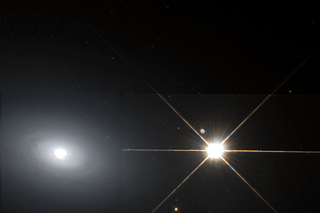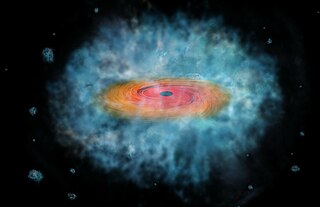
A black hole is a region of spacetime where gravity is so strong that nothing, including light and other electromagnetic waves, are capable of possessing enough energy to escape it. Einstein's theory of general relativity predicts that a sufficiently compact mass can deform spacetime to form a black hole. The boundary of no escape is called the event horizon. A black hole has a great effect on the fate and circumstances of an object crossing it, but it has no locally detectable features according to general relativity. In many ways, a black hole acts like an ideal black body, as it reflects no light. Moreover, quantum field theory in curved spacetime predicts that event horizons emit Hawking radiation, with the same spectrum as a black body of a temperature inversely proportional to its mass. This temperature is of the order of billionths of a kelvin for stellar black holes, making it essentially impossible to observe directly.

A supermassive black hole is the largest type of black hole, with its mass being on the order of hundreds of thousands, or millions to billions, of times the mass of the Sun (M☉). Black holes are a class of astronomical objects that have undergone gravitational collapse, leaving behind spheroidal regions of space from which nothing can escape, not even light. Observational evidence indicates that almost every large galaxy has a supermassive black hole at its center. For example, the Milky Way galaxy has a supermassive black hole at its center, corresponding to the radio source Sagittarius A*. Accretion of interstellar gas onto supermassive black holes is the process responsible for powering active galactic nuclei (AGNs) and quasars.

An intermediate-mass black hole (IMBH) is a class of black hole with mass in the range 102–105 solar masses: significantly more than stellar black holes but less than the 105–109 solar mass supermassive black holes. Several IMBH candidate objects have been discovered in the Milky Way galaxy and others nearby, based on indirect gas cloud velocity and accretion disk spectra observations of various evidentiary strength.

A stellar black hole is a black hole formed by the gravitational collapse of a star. They have masses ranging from about 5 to several tens of solar masses. They are the remnants of supernova explosions, which may be observed as a type of gamma ray burst. These black holes are also referred to as collapsars.

Messier 63 or M63, also known as NGC 5055 or the seldom-used Sunflower Galaxy, is a spiral galaxy in the northern constellation of Canes Venatici with approximately 400 billion stars. M63 was first discovered by the French astronomer Pierre Méchain, then later verified by his colleague Charles Messier on June 14, 1779. The galaxy became listed as object 63 in the Messier Catalogue. In the mid-19th century, Anglo-Irish astronomer Lord Rosse identified spiral structures within the galaxy, making this one of the first galaxies in which such structure was identified.
In astrophysics and particle physics, self-interacting dark matter (SIDM) is an alternative class of dark matter particles which have strong interactions, in contrast to the standard cold dark matter model (CDM). SIDM was postulated in 2000 as a solution to the core-cusp problem. In the simplest models of DM self-interactions, a Yukawa-type potential and a force carrier φ mediates between two dark matter particles. On galactic scales, DM self-interaction leads to energy and momentum exchange between DM particles. Over cosmological time scales this results in isothermal cores in the central region of dark matter haloes.

A quasi-star is a hypothetical type of extremely massive and luminous star that may have existed early in the history of the Universe. Unlike modern stars, which are powered by nuclear fusion in their cores, a quasi-star's energy would come from material falling into a black hole at its core.

Katherine Freese is a theoretical astrophysicist. She is currently a professor of physics at the University of Texas at Austin, where she holds the Jeff and Gail Kodosky Endowed Chair in Physics. She is known for her work in theoretical cosmology at the interface of particle physics and astrophysics.
Current observations suggest that the expansion of the universe will continue forever. The prevailing theory is that the universe will cool as it expands, eventually becoming too cold to sustain life. For this reason, this future scenario once popularly called "Heat Death" is now known as the "Big Chill" or "Big Freeze".

In cosmology, primordial black holes (PBHs) are hypothetical black holes that formed soon after the Big Bang. In the inflationary era and early radiation-dominated universe, extremely dense pockets of subatomic matter may have been tightly packed to the point of gravitational collapse, creating primordial black holes without the supernova compression typically needed to make black holes today. Because the creation of primordial black holes would pre-date the first stars, they are not limited to the narrow mass range of stellar black holes.

NGC 1277 is a lenticular galaxy in the constellation of Perseus. It is a member of the Perseus Cluster of galaxies and is located approximately 73 Mpc (megaparsecs) or 220 million light-years from the Milky Way. It has an apparent magnitude of about 14.7. It was discovered on December 4, 1875 by Lawrence Parsons, 4th Earl of Rosse.

NGC 1052 is an elliptical galaxy in the constellation Cetus. It was discovered on January 10, 1785 by the astronomer William Herschel. It is a member of the eponymous NGC 1052 Group.

Holmberg 15A is a supergiant elliptical galaxy and the central dominant galaxy of the Abell 85 galaxy cluster in the constellation Cetus, about 700 million light-years from Earth. It was discovered c. 1937 by Erik Holmberg. It became well known when it was reported to have the largest core ever observed in a galaxy, spanning some 15,000 light years, however this was subsequently refuted.

NGC 4473 is an elliptical galaxy located about 50 million light-years away in the constellation of Coma Berenices. It was discovered by astronomer William Herschel on April 8, 1784. NGC 4473 has an inclination of about 71°. NGC 4473 is a member of a chain of galaxies called Markarian's Chain which is part of the larger Virgo Cluster of galaxies.

NGC 3585 is an elliptical or a lenticular galaxy located in the constellation Hydra. It is located at a distance of circa 60 million light-years from Earth, which, given its apparent dimensions, means that NGC 3585 is about 80,000 light years across. It was discovered by William Herschel on December 9, 1784.

NGC 2974 is a lenticular galaxy located in the constellation Sextans. It is located at a distance of circa 90 million light years from Earth, which, given its apparent dimensions, means that NGC 2974 is about 90,000 light years across. It was discovered by William Herschel on January 6, 1785. NGC 2974 is located in the sky about 2 and a half degrees south-south east of Iota Hydrae and more than 6 degrees northeast of Alphard. A 10th magnitude star lies next to the galaxy, thus making it a challenging object at low magnifications. NGC 2974 is part of the Herschel 400 Catalogue.

Direct collapse black holes (DCBHs) are high-mass black hole seeds, putatively formed within the redshift range z=15–30, when the Universe was about 100–250 million years old. Unlike seeds formed from the first population of stars (also known as Population III stars), direct collapse black hole seeds are formed by a direct, general relativistic instability. They are very massive, with a typical mass at formation of ~105 M☉. This category of black hole seeds was originally proposed theoretically to alleviate the challenge in building supermassive black holes already at redshift z~7, as numerous observations to date have confirmed.

QSO J0313−1806 was the most distant, and hence also the oldest known quasar at z = 7.64, at the time of its discovery. In January 2021, it was identified as the most redshifted (highest z) known quasar, with the oldest known supermassive black hole (SMBH) at (1.6±0.4)×109 solar masses. The 2021 announcement paper described it as "the most massive SMBH at z > 7". This quasar beat the prior recordsetting quasar, ULAS J1342+0928. In 2023, UHZ1 was discovered, setting a new record for most distant quasar, eclipsing that of QSO J0313−1806.

JADES-GS-z13-0 is a high-redshift Lyman-break galaxy discovered by the James Webb Space Telescope (JWST) during NIRCam imaging for the JWST Advanced Deep Extragalactic Survey (JADES) on 29 September 2022. Spectroscopic observations by JWST's NIRSpec instrument in October 2022 confirmed the galaxy's redshift of z = 13.2 to a high accuracy, establishing it as the oldest and most distant spectroscopically-confirmed galaxy known as of 2023, with a light-travel distance of 13.4 billion years. Due to the expansion of the universe, its present proper distance is 33.6 billion light-years.



















